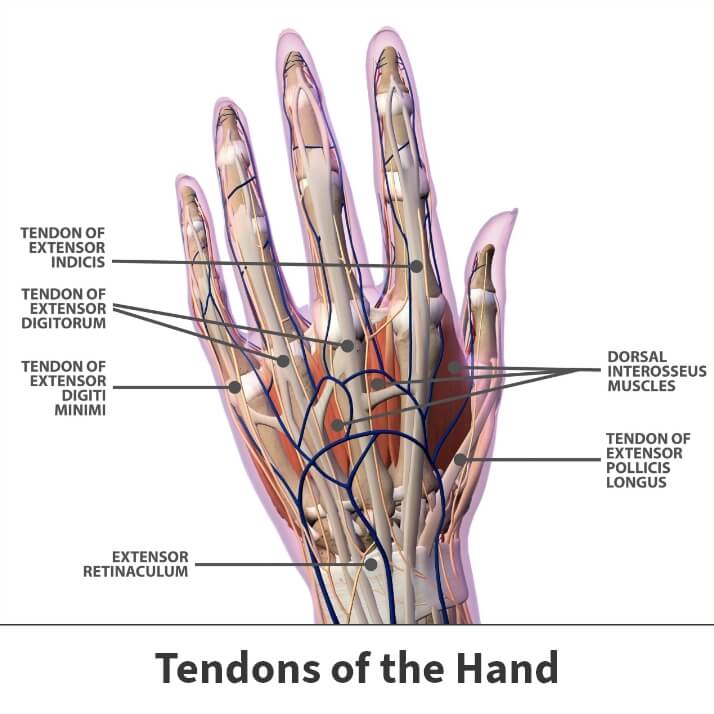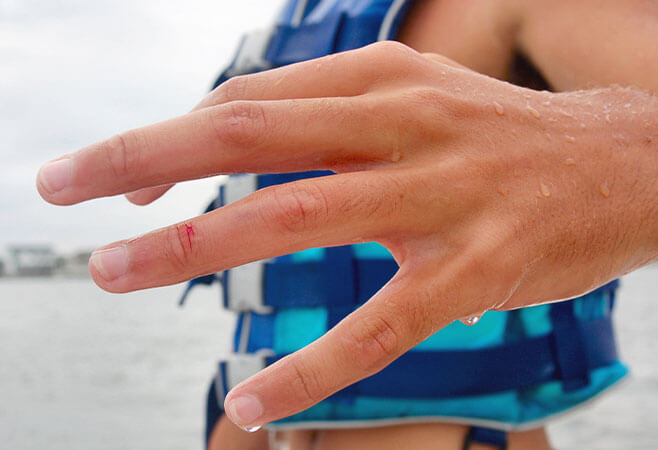Dislocated finger
A finger dislocation is a common injury that results in the joints in the finger becoming dislocated or moved from their original position. This injury is typically caused during sports, such as basketball or baseball, when the ball hits the finger in an outstretched position. This injury is treated non-surgically by putting the finger back into its correct position.
Anatomy

Tendons are tissues that connect muscles to bone. The muscles that move the fingers and thumb are located in the forearm. Long tendons extend from these muscles through the wrist and attach to the small bones of the fingers and thumb.
The extensor tendons on the top of the hand straighten the fingers. The flexor tendons on the palm side of the hand bend the fingers.
About
A finger dislocation is when the joints in the fingers become dislocated or knocked out of their correct alignment. While this can happen to any finger, the most common dislocations happen to the little, ring, middle, and index finger.
Finger dislocations are most commonly caused by a jamming force that is applied to the end of a finger, or when a finger is forcefully overextended. The most common activities that result in dislocated fingers include:
- Sports activities, such as basketball or baseball, can lead to the ball striking the tip of an outstretched finger.
- Sports equipment such as jerseys or pads that the finger can get stuck in.
- Falling onto an outstretched hand.
Finger dislocations are typically the result of an accident, which makes it hard to prevent injury. But whenever possible, avoid getting your finger stuck in objects such as basketball nets, football helmets, and jewelry to greatly reduce your risk. Wearing protective gloves when necessary can also be helpful.
Symptoms
The main symptom of a dislocated finger is when the finger appears crooked and swollen.
The other symptoms associated with a dislocated finger include:
- Pain
- The injured finger is pale in color
- Numbness or tingling with a severe dislocation
- Bruising
- A break in the skin or cut where the finger was dislocated
If the finger dislocation causes the skin to break, seek medical attention as quickly as possible.

Diagnosis
Your Florida Orthopaedic Institute physician will take a look at your current symptoms, medical history, and current health. They will order an X-ray test to confirm the dislocation and look for any broken bones. X-rays produce images of dense structures in the body, such as bone.
Treatment
Dislocations are usually treated with reduction alone, however, sometimes they require surgery. They can be treated with nonsurgical treatments, such as reduction.
The first thing to do after dislocating your finger is to remove any jewelry, such as rings. Immediately after the injury, your finger will swell, and jewelry may interfere with your circulation, causing further problems. To help control the swelling, apply an ice pack to the injured finger, and elevate that hand above your heart.
When you visit your Florida Orthopaedic Institute physician, they may realign the dislocated bones nonsurgically in a procedure known as reduction. This typically involves a local anesthetic injection in the finger to help decrease or stop the pain, as well as allowing your physician to reduce the dislocation and realign the bones. Medications may also be given to help ease the pain.
Once the finger has been put back into place, it will be placed in a protective splint or be “buddy taped” to an adjacent healthy finger.
Videos
Related specialties
- Basal Joint Surgery
- Carpal Tunnel Syndrome
- De Quervain's Tenosynovitis
- Distal Radius Fracture (Broken Wrist)
- Dupuytren’s Disease
- Flexor Tendonitis
- Fractured Fingers
- Functional Nerve Transfers of the Hand
- Ganglion Cysts
- Hand & Finger Replantation
- Hand Nerve Decompression
- Hand Skin Grafts
- Nerve Pain
- Peripheral Nerve Surgery (Hand) Revision
- Revascularization of the Hand
- Rheumatoid Arthritis of the Hand
- Sports Wrist & Hand Injuries
- Sprained Wrist
- Sudden Acute Finger, Hand & Wrist Injuries
- Targeted Muscle Reinnervation (TMR)
- Tendon Transfers of the Hand
- Thumb Ulnar Collateral Ligament Injuries
- Trigger Finger
- Ulnar Neuritis
- WALANT (Wide Awake Local Anesthesia No Tourniquet)
- Wrist Arthroscopy
- Wrist Fractures
- Wrist Tendonitis
